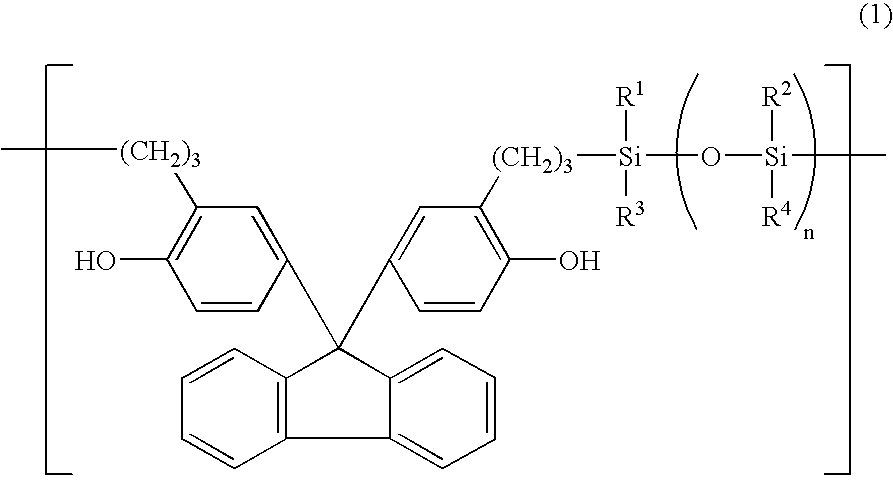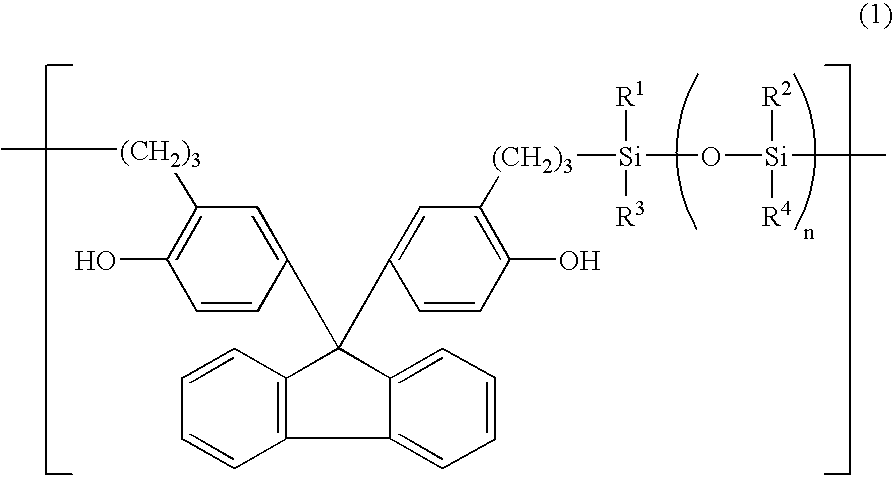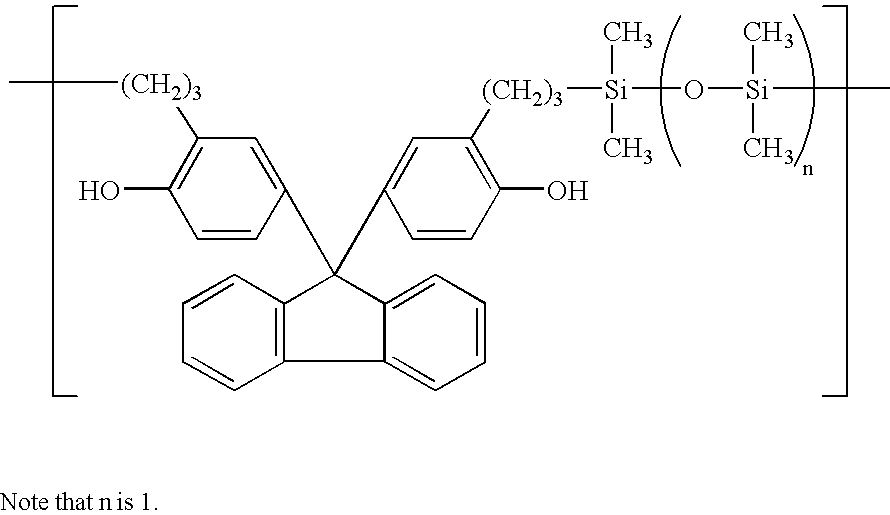Epoxy resin compositions
a technology of epoxy resin and composition, applied in the field of epoxy resin composition, can solve the problems of cracking of cured resin, internal stresses generated in the cured epoxy resin composition, and very hard and brittle epoxy resin compositions at the same tim
- Summary
- Abstract
- Description
- Claims
- Application Information
AI Technical Summary
Benefits of technology
Problems solved by technology
Method used
Image
Examples
synthesis example 1
[0034]A flask equipped with a stirrer, thermometer, nitrogen purge line and reflux condenser was charged with 43.0 g of 4,4′-(9H-fluoren-9-ylidene)bis[(2-propenyl)phenol], 60 g of toluene, and 0.1 g of chloroplatinic acid and heated at 80° C. Thereafter, 13.4 g of 1,3-dihydro-1,1,3,3-tetramethyl-disiloxane was added dropwise to the flask. The dropwise addition was followed by ripening at 100° C. for one hour. The toluene was then distilled off. There was obtained 54 g of a solid product.
[0035]On IR analysis of the product, the absorption peaks attributable to hydrosilyl and allyl groups were not observed, indicating that the reaction was completed. Instead, an absorption peak attributable to siloxane bond appeared at 1050 cm−1. On GPC analysis, the product had a weight average molecular weight of 18,000 as determined on a basis of polystyrene standards.
[0036]These structural analyses indicated that the product was an organosiloxane polymer having the recurring units shown below.
[003...
synthesis example 2
[0038]Aside from using 20.1 g of 4,4′-(9H-fluoren-9-ylidene)bis[(2-propenyl)phenol] and 37.3 g of dihydromethylpolysiloxane having the following formula:
[0039]
wherein n is 10, 54 g of a liquid product was obtained as in Synthesis Example 1. On similar GPC analysis, the product had a weight average molecular weight of 39,000 as determined on a basis of polystyrene standards.
[0040]Similar structural analyses indicated that the product was an organosiloxane polymer having the same recurring units as in Synthesis Example 1 except for n=10.
synthesis example 3
[0041]Aside from using 3.1 g of 4,4′-(9H-fluoren-9-ylidene)bis[(2-propenyl)phenol] and 54.2 g of dihydromethylpolysiloxane having the following formula:
[0042]
wherein n is 100, 54 g of a liquid product was obtained as in Synthesis Example 1. On similar GPC analysis, the product had a weight average molecular weight of 252,000 as determined on a basis of polystyrene standards. Similar structural analyses indicated that the product was an organosiloxane polymer having the same recurring units as in Synthesis Example 1 except for n=100.
[0043]The fluorene skeleton-bearing, silicone-modified phenolic resins (simply referred to as “fluorene phenolic resin” in Examples), the compounds having at least two epoxy groups in a molecule, and the cure accelerators used in Examples are shown below.
Fluorene Phenolic Resin 1:
[0044]prepared in Synthesis Example 1
[0045]silicone content 23 wt %
[0046]phenolic hydroxyl equivalent 282
Fluorene Phenolic Resin 2:
[0047]prepared in Synthesis Example 2
[0048]sili...
PUM
| Property | Measurement | Unit |
|---|---|---|
| temperature | aaaaa | aaaaa |
| thick | aaaaa | aaaaa |
| thick | aaaaa | aaaaa |
Abstract
Description
Claims
Application Information
 Login to View More
Login to View More - R&D
- Intellectual Property
- Life Sciences
- Materials
- Tech Scout
- Unparalleled Data Quality
- Higher Quality Content
- 60% Fewer Hallucinations
Browse by: Latest US Patents, China's latest patents, Technical Efficacy Thesaurus, Application Domain, Technology Topic, Popular Technical Reports.
© 2025 PatSnap. All rights reserved.Legal|Privacy policy|Modern Slavery Act Transparency Statement|Sitemap|About US| Contact US: help@patsnap.com



